2022年中考英语总复习专题课件★☆主谓一致公开课(共33张PPT)
文档属性
| 名称 | 2022年中考英语总复习专题课件★☆主谓一致公开课(共33张PPT) |  | |
| 格式 | zip | ||
| 文件大小 | 1.1MB | ||
| 资源类型 | 教案 | ||
| 版本资源 | 人教新目标(Go for it)版 | ||
| 科目 | 英语 | ||
| 更新时间 | 2022-05-13 15:57:06 | ||
图片预览

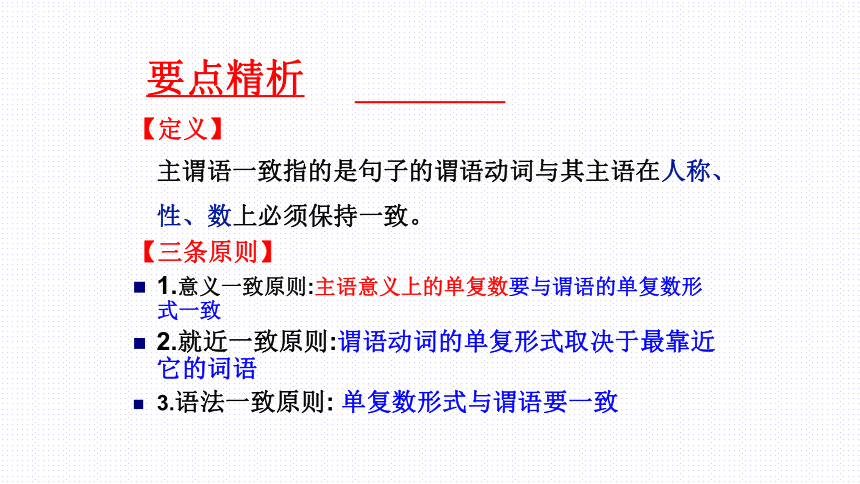
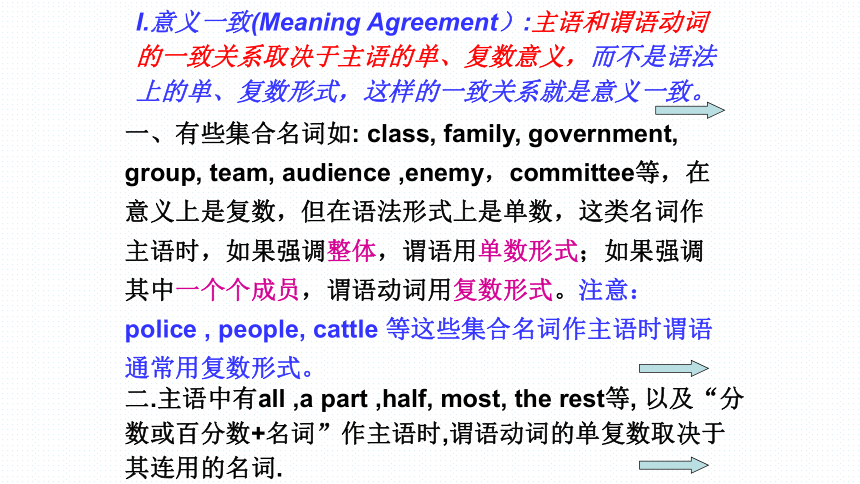
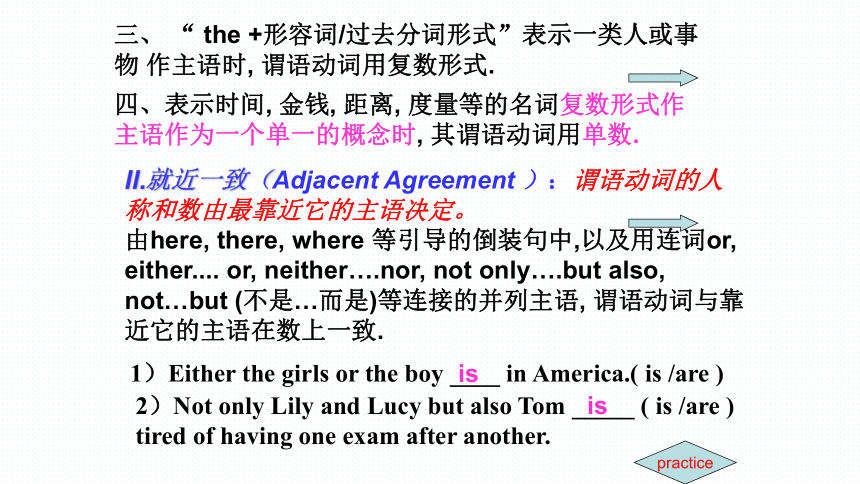
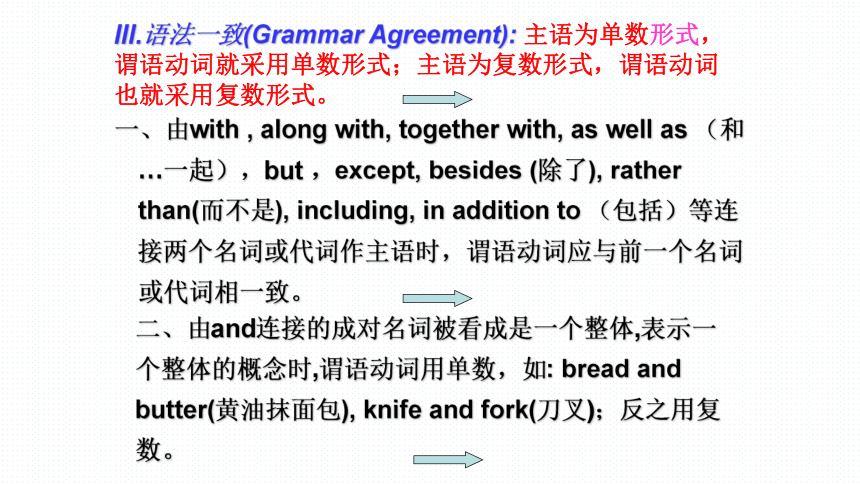
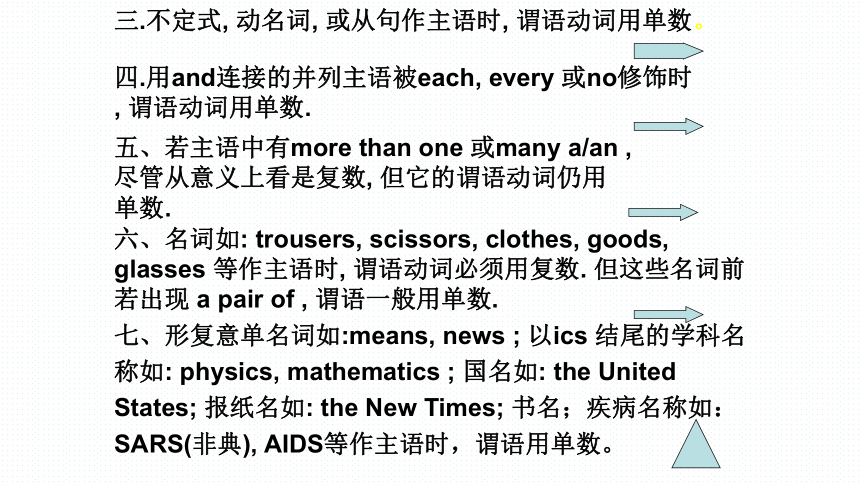
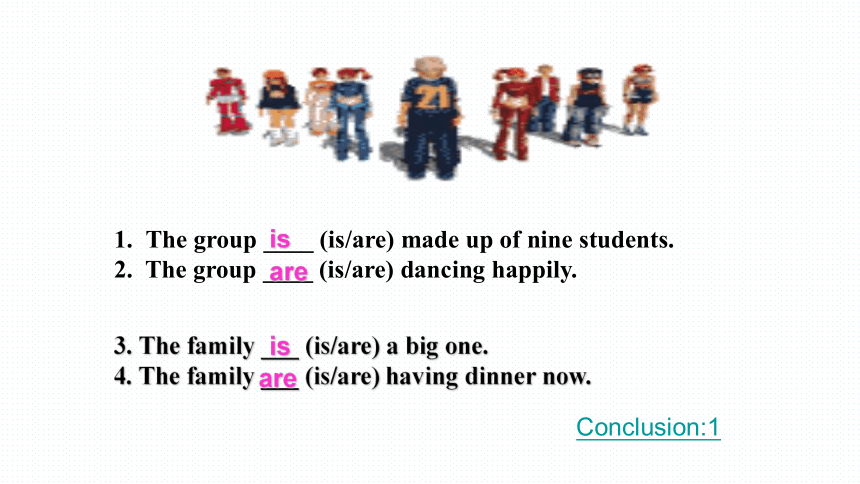
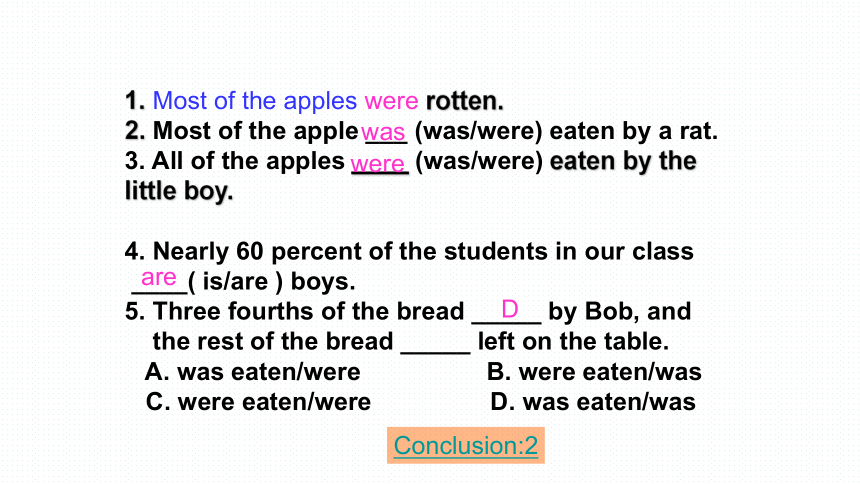
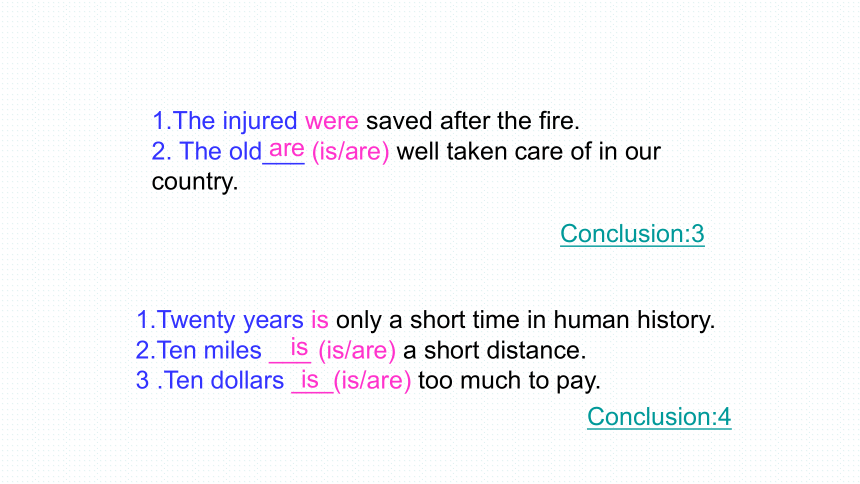
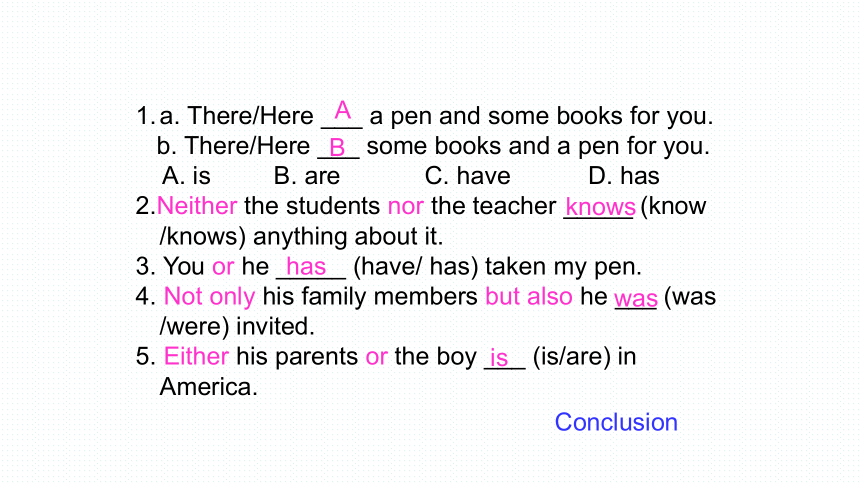
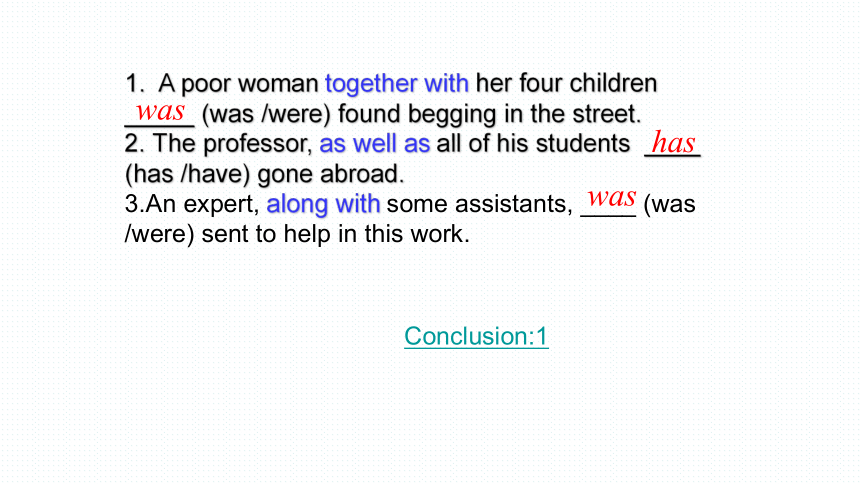
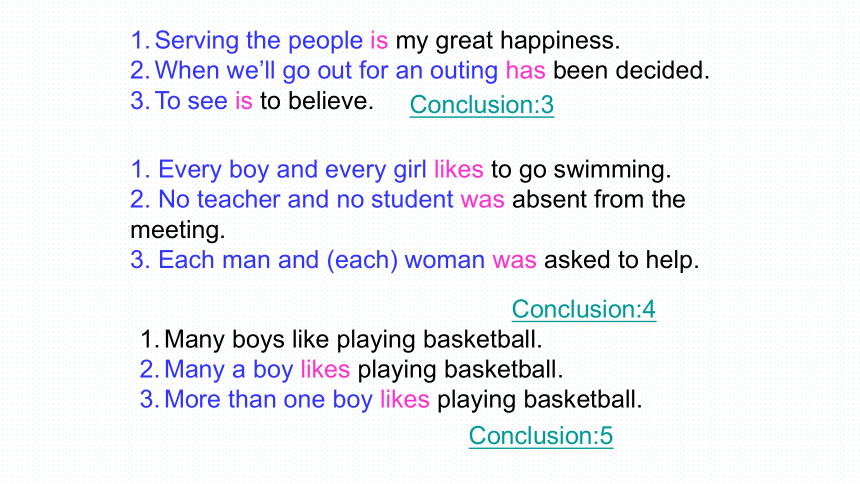
文档简介
(共33张PPT)
2022年中考英语总复习专题课件★☆
主谓一致
要点精析
【定义】
主谓语一致指的是句子的谓语动词与其主语在人称、性、数上必须保持一致。
【三条原则】
1.意义一致原则:主语意义上的单复数要与谓语的单复数形式一致
2.就近一致原则:谓语动词的单复形式取决于最靠近它的词语
3.语法一致原则: 单复数形式与谓语要一致
I.意义一致(Meaning Agreement):主语和谓语动词的一致关系取决于主语的单、复数意义,而不是语法上的单、复数形式,这样的一致关系就是意义一致。
二.主语中有all ,a part ,half, most, the rest等, 以及“分数或百分数+名词”作主语时,谓语动词的单复数取决于其连用的名词.
一、有些集合名词如: class, family, government, group, team, audience ,enemy,committee等,在意义上是复数,但在语法形式上是单数,这类名词作主语时,如果强调整体,谓语用单数形式;如果强调其中一个个成员,谓语动词用复数形式。注意:police , people, cattle 等这些集合名词作主语时谓语通常用复数形式。
三、 “ the +形容词/过去分词形式”表示一类人或事物 作主语时, 谓语动词用复数形式.
四、表示时间, 金钱, 距离, 度量等的名词复数形式作主语作为一个单一的概念时, 其谓语动词用单数.
II.就近一致(Adjacent Agreement ):谓语动词的人称和数由最靠近它的主语决定。
由here, there, where 等引导的倒装句中,以及用连词or, either.... or, neither….nor, not only….but also, not…but (不是…而是)等连接的并列主语, 谓语动词与靠近它的主语在数上一致.
1)Either the girls or the boy ____ in America.( is /are )
2)Not only Lily and Lucy but also Tom _____ ( is /are ) tired of having one exam after another.
is
is
practice
III.语法一致(Grammar Agreement): 主语为单数形式,谓语动词就采用单数形式;主语为复数形式,谓语动词也就采用复数形式。
一、由with , along with, together with, as well as (和…一起),but ,except, besides (除了), rather than(而不是), including, in addition to (包括)等连接两个名词或代词作主语时,谓语动词应与前一个名词或代词相一致。
二、由and连接的成对名词被看成是一个整体,表示一个整体的概念时,谓语动词用单数,如: bread and butter(黄油抹面包), knife and fork(刀叉);反之用复数。
三.不定式, 动名词, 或从句作主语时, 谓语动词用单数。
四.用and连接的并列主语被each, every 或no修饰时, 谓语动词用单数.
五、若主语中有more than one 或many a/an , 尽管从意义上看是复数, 但它的谓语动词仍用单数.
六、名词如: trousers, scissors, clothes, goods, glasses 等作主语时, 谓语动词必须用复数. 但这些名词前若出现 a pair of , 谓语一般用单数.
七、形复意单名词如:means, news ; 以ics 结尾的学科名称如: physics, mathematics ; 国名如: the United States; 报纸名如: the New Times; 书名;疾病名称如:SARS(非典), AIDS等作主语时,谓语用单数。
3. The family ___ (is/are) a big one.
4. The family ___ (is/are) having dinner now.
Conclusion:1
are
is
1. The group ____ (is/are) made up of nine students.
2. The group ____ (is/are) dancing happily.
is
are
1. Most of the apples were rotten.
2. Most of the apple ___ (was/were) eaten by a rat.
3. All of the apples ____ (was/were) eaten by the
little boy.
4. Nearly 60 percent of the students in our class
____( is/are ) boys.
5. Three fourths of the bread _____ by Bob, and
the rest of the bread _____ left on the table.
A. was eaten/were B. were eaten/was
C. were eaten/were D. was eaten/was
are
D
Conclusion:2
was
were
Conclusion:3
1.Twenty years is only a short time in human history.
2.Ten miles ___ (is/are) a short distance.
3 .Ten dollars ___(is/are) too much to pay.
Conclusion:4
1.The injured were saved after the fire.
2. The old___ (is/are) well taken care of in our country.
are
is
is
a. There/Here ___ a pen and some books for you.
b. There/Here ___ some books and a pen for you.
A. is B. are C. have D. has
2.Neither the students nor the teacher _____ (know /knows) anything about it.
3. You or he _____ (have/ has) taken my pen.
4. Not only his family members but also he ___ (was /were) invited.
5. Either his parents or the boy ___ (is/are) in America.
Conclusion
A
B
knows
has
was
is
1. A poor woman together with her four children
_____ (was /were) found begging in the street.
2. The professor, as well as all of his students ____
(has /have) gone abroad.
3.An expert, along with some assistants, ____ (was /were) sent to help in this work.
was
has
Conclusion:1
was
Serving the people is my great happiness.
When we’ll go out for an outing has been decided.
To see is to believe.
Conclusion:3
1. Every boy and every girl likes to go swimming.
2. No teacher and no student was absent from the meeting.
3. Each man and (each) woman was asked to help.
Conclusion:4
Many boys like playing basketball.
Many a boy likes playing basketball.
More than one boy likes playing basketball.
Conclusion:5
1.Glasses ___(are/is)useful.眼镜有用。
2.A pair of glasses ___ (are/is) on the desk. 桌上有一副眼镜.
Conclusion:6
1. The United States _____ (are/is) a powerful country with diverse culture.
2. Politics _____ (are/is) not easy for the students to learn well.
Conclusion:7
are
is
is
is
A hammer and a saw are useful tools.
锤子和锯都是有用的工具. (两样物)
2. The poet and the writer ____ (have/has) come.
3. The poet and writer____ (have/has) come.
那位诗人兼作家来了.
Conclusion:2
have
has
1. a. I can work out two of the five problems, but the rest ___ too difficult for me.
b. I have finished one third of the work, and the rest ___left for you.
A. is B. are C. has D. have
Practice
3. a. My family ____ a big one.
b. The family ____ sitting round the table now.
A. is B. were C. was D. are
B
A
A
D
2. a. Either you or I ___ going to the teacher’s
office after class.
b. ___ either you or I going to the teacher’s office after class
A. is B. are C. am D. has
c
B
4. a. There ___ a magazine, a few letters and some newspapers on the table.
b. There ___ a few letters, a magazine and some newspaper on the table.
A. is B. are C. have D. has
5. a. The rest of the students in the school ___ going to stay at school.
b. The rest of his income ___ to give to his mother.
A. is B. are C. am D. be
6. a. Neither my parents nor my sister ___ known the secret.
b. Neither my sister nor my parents ___ known the secret.
A. have B. has C. am D. be
A
B
B
A
B
A
Most of the people in the Philippines _____ (is/are) black.
2. Half of this work ___ (have/has) been finished.
3. One or perhaps more pages ____ (was/were) lost.
4. Two hours ____ (is/are) enough for us to finish the work.
5. Nearly 60 percent of the teachers in our school ____
(is/are) men.
6. The youth ____(is/are) fond of surfing the Internet.
7. Forty dollars ___ (is/are) a big sum to him.
8. There ___ (is/are) some water and stones in the bottle.
Fill in the blanks.
are
has
were
is
are
are
is
is
要点精析
【定义】
主谓语一致指的是句子的谓语动词与其主语在人称、性、数上必须保持一致。
【三条原则】
1.意义一致原则:主语意义上的单复数要与谓语的单复数形式一致
2.就近一致原则:谓语动词的单复形式取决于最靠近它的词语
3.语法一致原则: 单复数形式与谓语要一致
(一)意义一致(语言内容上一致)
1. family
school
class
team
group
government
public
+复数谓语v(表示个体)
+单数谓语v(表示整体)
2. people
police
cattle
+复数谓语v
3.news
the United States
economics
maths
physics
politics
+单数谓语v
trousers
clothes
goods
glasses
+复数谓语v
4. each/every+n+ and+ (each/every)+n
+单数谓语 v
5. 数词和表示时间、距离、重量、度量、衡量、金钱等复数名词作主语,谓语v常用单数形式
(二)、就近原则(就近原则)
1. A or B
Either A or B
Nether A nor B
Not only A but also B
+谓语v与B一致
2. 在there be 的结构中,谓语动词的单复数形式一般也采取就近原则
3.倒装。谓语与紧跟在后面的主语一致。
(三)、语法形式一致
1. n./pron.(Single)
To do sth
Doing sth
A sentence
+单数谓语v
2. n./pron.(pl.)
Both A and B
To do A and to do B
Doing A and doing B
A sentence and a sentence
+复数谓语v
3. including
as well as
with
along with
together with
accompanied by
except/ but/besides
rather than
A+
+B+谓语v
(与主语A一致)
4. Either
Neither
Each
The other
Another
Some/any/no/every+body(one;thing)
+单数谓语v
5. The +n +and +n +单数谓语v
The +n +and + the +n +复数谓语v
6.The+adj. (表示一类人)+复数谓语v
7.all of
most of
a lot of
some of
plenty of
the majority of
+不可数名词+单数谓语v
+可数名词单数+单数谓语v
可数名词复数+复数谓语v
8. more than one (+ 单数名词)
many a + 单数名词
+单数谓语v
9.分数
百分数
+of
+单数名词/代词+单数谓语v
+复数名词/代词+复数谓语v
2022年中考英语总复习专题课件★☆
主谓一致
要点精析
【定义】
主谓语一致指的是句子的谓语动词与其主语在人称、性、数上必须保持一致。
【三条原则】
1.意义一致原则:主语意义上的单复数要与谓语的单复数形式一致
2.就近一致原则:谓语动词的单复形式取决于最靠近它的词语
3.语法一致原则: 单复数形式与谓语要一致
I.意义一致(Meaning Agreement):主语和谓语动词的一致关系取决于主语的单、复数意义,而不是语法上的单、复数形式,这样的一致关系就是意义一致。
二.主语中有all ,a part ,half, most, the rest等, 以及“分数或百分数+名词”作主语时,谓语动词的单复数取决于其连用的名词.
一、有些集合名词如: class, family, government, group, team, audience ,enemy,committee等,在意义上是复数,但在语法形式上是单数,这类名词作主语时,如果强调整体,谓语用单数形式;如果强调其中一个个成员,谓语动词用复数形式。注意:police , people, cattle 等这些集合名词作主语时谓语通常用复数形式。
三、 “ the +形容词/过去分词形式”表示一类人或事物 作主语时, 谓语动词用复数形式.
四、表示时间, 金钱, 距离, 度量等的名词复数形式作主语作为一个单一的概念时, 其谓语动词用单数.
II.就近一致(Adjacent Agreement ):谓语动词的人称和数由最靠近它的主语决定。
由here, there, where 等引导的倒装句中,以及用连词or, either.... or, neither….nor, not only….but also, not…but (不是…而是)等连接的并列主语, 谓语动词与靠近它的主语在数上一致.
1)Either the girls or the boy ____ in America.( is /are )
2)Not only Lily and Lucy but also Tom _____ ( is /are ) tired of having one exam after another.
is
is
practice
III.语法一致(Grammar Agreement): 主语为单数形式,谓语动词就采用单数形式;主语为复数形式,谓语动词也就采用复数形式。
一、由with , along with, together with, as well as (和…一起),but ,except, besides (除了), rather than(而不是), including, in addition to (包括)等连接两个名词或代词作主语时,谓语动词应与前一个名词或代词相一致。
二、由and连接的成对名词被看成是一个整体,表示一个整体的概念时,谓语动词用单数,如: bread and butter(黄油抹面包), knife and fork(刀叉);反之用复数。
三.不定式, 动名词, 或从句作主语时, 谓语动词用单数。
四.用and连接的并列主语被each, every 或no修饰时, 谓语动词用单数.
五、若主语中有more than one 或many a/an , 尽管从意义上看是复数, 但它的谓语动词仍用单数.
六、名词如: trousers, scissors, clothes, goods, glasses 等作主语时, 谓语动词必须用复数. 但这些名词前若出现 a pair of , 谓语一般用单数.
七、形复意单名词如:means, news ; 以ics 结尾的学科名称如: physics, mathematics ; 国名如: the United States; 报纸名如: the New Times; 书名;疾病名称如:SARS(非典), AIDS等作主语时,谓语用单数。
3. The family ___ (is/are) a big one.
4. The family ___ (is/are) having dinner now.
Conclusion:1
are
is
1. The group ____ (is/are) made up of nine students.
2. The group ____ (is/are) dancing happily.
is
are
1. Most of the apples were rotten.
2. Most of the apple ___ (was/were) eaten by a rat.
3. All of the apples ____ (was/were) eaten by the
little boy.
4. Nearly 60 percent of the students in our class
____( is/are ) boys.
5. Three fourths of the bread _____ by Bob, and
the rest of the bread _____ left on the table.
A. was eaten/were B. were eaten/was
C. were eaten/were D. was eaten/was
are
D
Conclusion:2
was
were
Conclusion:3
1.Twenty years is only a short time in human history.
2.Ten miles ___ (is/are) a short distance.
3 .Ten dollars ___(is/are) too much to pay.
Conclusion:4
1.The injured were saved after the fire.
2. The old___ (is/are) well taken care of in our country.
are
is
is
a. There/Here ___ a pen and some books for you.
b. There/Here ___ some books and a pen for you.
A. is B. are C. have D. has
2.Neither the students nor the teacher _____ (know /knows) anything about it.
3. You or he _____ (have/ has) taken my pen.
4. Not only his family members but also he ___ (was /were) invited.
5. Either his parents or the boy ___ (is/are) in America.
Conclusion
A
B
knows
has
was
is
1. A poor woman together with her four children
_____ (was /were) found begging in the street.
2. The professor, as well as all of his students ____
(has /have) gone abroad.
3.An expert, along with some assistants, ____ (was /were) sent to help in this work.
was
has
Conclusion:1
was
Serving the people is my great happiness.
When we’ll go out for an outing has been decided.
To see is to believe.
Conclusion:3
1. Every boy and every girl likes to go swimming.
2. No teacher and no student was absent from the meeting.
3. Each man and (each) woman was asked to help.
Conclusion:4
Many boys like playing basketball.
Many a boy likes playing basketball.
More than one boy likes playing basketball.
Conclusion:5
1.Glasses ___(are/is)useful.眼镜有用。
2.A pair of glasses ___ (are/is) on the desk. 桌上有一副眼镜.
Conclusion:6
1. The United States _____ (are/is) a powerful country with diverse culture.
2. Politics _____ (are/is) not easy for the students to learn well.
Conclusion:7
are
is
is
is
A hammer and a saw are useful tools.
锤子和锯都是有用的工具. (两样物)
2. The poet and the writer ____ (have/has) come.
3. The poet and writer____ (have/has) come.
那位诗人兼作家来了.
Conclusion:2
have
has
1. a. I can work out two of the five problems, but the rest ___ too difficult for me.
b. I have finished one third of the work, and the rest ___left for you.
A. is B. are C. has D. have
Practice
3. a. My family ____ a big one.
b. The family ____ sitting round the table now.
A. is B. were C. was D. are
B
A
A
D
2. a. Either you or I ___ going to the teacher’s
office after class.
b. ___ either you or I going to the teacher’s office after class
A. is B. are C. am D. has
c
B
4. a. There ___ a magazine, a few letters and some newspapers on the table.
b. There ___ a few letters, a magazine and some newspaper on the table.
A. is B. are C. have D. has
5. a. The rest of the students in the school ___ going to stay at school.
b. The rest of his income ___ to give to his mother.
A. is B. are C. am D. be
6. a. Neither my parents nor my sister ___ known the secret.
b. Neither my sister nor my parents ___ known the secret.
A. have B. has C. am D. be
A
B
B
A
B
A
Most of the people in the Philippines _____ (is/are) black.
2. Half of this work ___ (have/has) been finished.
3. One or perhaps more pages ____ (was/were) lost.
4. Two hours ____ (is/are) enough for us to finish the work.
5. Nearly 60 percent of the teachers in our school ____
(is/are) men.
6. The youth ____(is/are) fond of surfing the Internet.
7. Forty dollars ___ (is/are) a big sum to him.
8. There ___ (is/are) some water and stones in the bottle.
Fill in the blanks.
are
has
were
is
are
are
is
is
要点精析
【定义】
主谓语一致指的是句子的谓语动词与其主语在人称、性、数上必须保持一致。
【三条原则】
1.意义一致原则:主语意义上的单复数要与谓语的单复数形式一致
2.就近一致原则:谓语动词的单复形式取决于最靠近它的词语
3.语法一致原则: 单复数形式与谓语要一致
(一)意义一致(语言内容上一致)
1. family
school
class
team
group
government
public
+复数谓语v(表示个体)
+单数谓语v(表示整体)
2. people
police
cattle
+复数谓语v
3.news
the United States
economics
maths
physics
politics
+单数谓语v
trousers
clothes
goods
glasses
+复数谓语v
4. each/every+n+ and+ (each/every)+n
+单数谓语 v
5. 数词和表示时间、距离、重量、度量、衡量、金钱等复数名词作主语,谓语v常用单数形式
(二)、就近原则(就近原则)
1. A or B
Either A or B
Nether A nor B
Not only A but also B
+谓语v与B一致
2. 在there be 的结构中,谓语动词的单复数形式一般也采取就近原则
3.倒装。谓语与紧跟在后面的主语一致。
(三)、语法形式一致
1. n./pron.(Single)
To do sth
Doing sth
A sentence
+单数谓语v
2. n./pron.(pl.)
Both A and B
To do A and to do B
Doing A and doing B
A sentence and a sentence
+复数谓语v
3. including
as well as
with
along with
together with
accompanied by
except/ but/besides
rather than
A+
+B+谓语v
(与主语A一致)
4. Either
Neither
Each
The other
Another
Some/any/no/every+body(one;thing)
+单数谓语v
5. The +n +and +n +单数谓语v
The +n +and + the +n +复数谓语v
6.The+adj. (表示一类人)+复数谓语v
7.all of
most of
a lot of
some of
plenty of
the majority of
+不可数名词+单数谓语v
+可数名词单数+单数谓语v
可数名词复数+复数谓语v
8. more than one (+ 单数名词)
many a + 单数名词
+单数谓语v
9.分数
百分数
+of
+单数名词/代词+单数谓语v
+复数名词/代词+复数谓语v
同课章节目录
- 词法
- 名词
- 动词和动词短语
- 动词语态
- 动词时态
- 助动词和情态动词
- 非谓语动词
- 冠词
- 代词
- 数词和量词
- 形容词副词及其比较等级
- 介词和介词短语
- 连词和感叹词
- 构词法
- 相似、相近词比较
- 句法
- 陈述句
- 一般疑问句和否定疑问句
- 特殊疑问句及选择疑问句
- 反意疑问句
- 存在句(There be句型)
- 宾语从句
- 定语从句
- 状语从句
- 主谓一致问题
- 简单句
- 并列句
- 复合句
- 主谓一致
- 主、表语从句
- 名词性从句
- 直接引语和间接引语
- 虚拟语气
- 感叹句
- 强调句
- 倒装句
- 祈使句
- 句子的成分
- 句子的分类
- 题型专区
- 单项选择部分
- 易错题
- 完形填空
- 阅读理解
- 词汇练习
- 听说训练
- 句型转换
- 补全对话
- 短文改错
- 翻译
- 书面表达
- 任务型阅读
- 语法填空
- 其他资料
